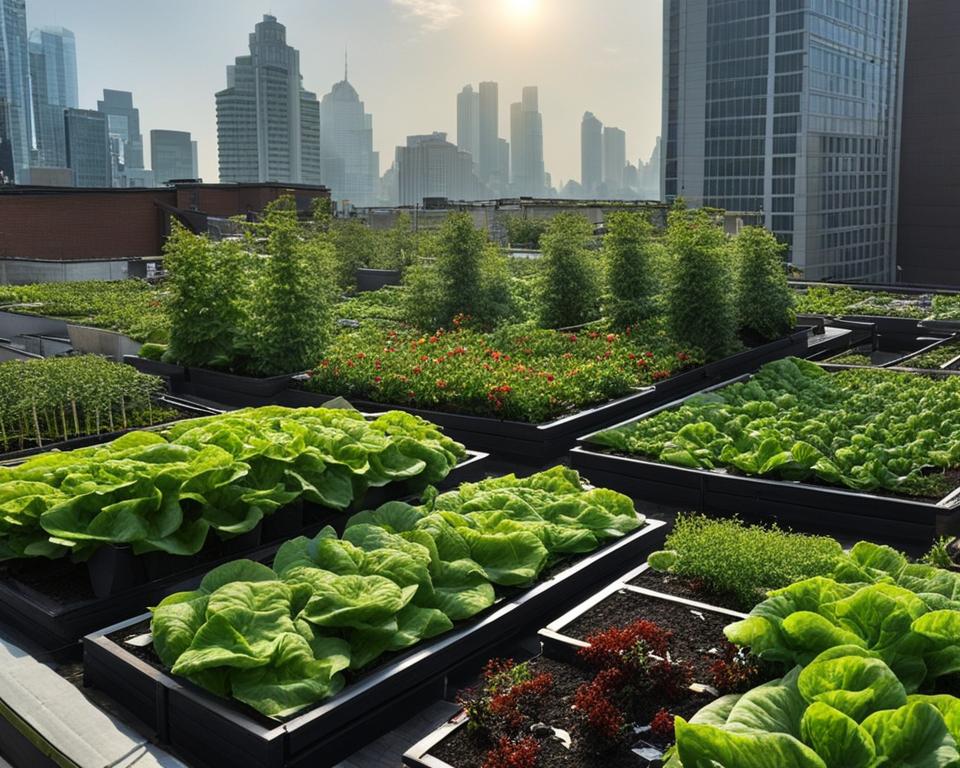Think living in a bustling metropolis means you have to say goodbye to the joys of horticulture? Think again! Urban vegetable gardening is your ticket to harvesting fresh produce right in the heart of city spaces. With a touch of creativity and the right urban gardening tips, anyone can transform their balcony, patio, or windowsill into a verdant patch bursting with homegrown flavors. It’s time to roll up your sleeves and dig into the world of city vegetable gardens – because green thumb successes aren’t just reserved for sprawling country fields.
If you’ve been yearning to plate up vegetables picked from your very own garden, urban living won’t curb your ambitions. In fact, it offers a unique canvas to craft a lush, edible landscape that merges seamlessly with the rhythm of city life. Not only will your city vegetable garden enliven your dining experience with straight-from-the-stalk ingredients, but it’ll also serve as a tranquil escape from the digital blur and concrete buzz.
Key Takeaways
- Maximize limited city spaces by choosing suitable containers and placing them in sun-kissed spots best for growth.
- Urban vegetable gardening can yield an abundance of fresh produce if planned correctly, an ideal solution for those looking for healthier food options.
- Small areas like balconies and windowsills can become productive gardens with the right care and selection of plants.
- Adopting container gardening in urban environments helps control soil quality and simplifies maintenance tasks.
- Create an efficient urban garden by selecting high-yield crops and managing space with vertical gardening techniques.
- Whether you’re a beginner or a seasoned green-thumb, urban gardening tips can guide you to successfully cultivate your cityscape oasis.
Embracing Small Space Solutions: Urban Vegetable Gardening Basics
Are you wondering how you can delve into urban vegetable gardening when you’re short on space? Fear not, for container gardening and clever space utilization are transformative, breathing life into your vision of a lush, edible haven. Urban gardening ideas that cater to small-space gardening challenges are not only achievable; they are remarkably efficient. As you explore the realms of growing plants in a limited area, you embark on an eco-friendly journey, contributing positively to your wellbeing and the environment. By focusing on maximized yield, you can relish in the bounty of your very own urban oasis.
The Essentials of Container Gardening
For the dynamic urban gardeners living in the fast-paced cityscape, space mustn’t become a barrier to growing your own vegetables. Container gardening is the versatile ally that makes this possible. Selecting the right type of containers is a dance of balance, marrying aesthetics with function. The key is to ensure appropriate size and adequate drainage to avoid waterlogging and provide roots the space to flourish.
Maximizing Yield in Minimal Areas
Believe it or not, a small balcony or window ledge can transform into a micro-farm! By choosing the proper vegetables for the respective container sizes, you can accelerate your urban garden’s productivity. Smaller containers are perfect for herbs and leafy greens, which require less root space, while larger tubs can house robust plants like tomatoes and peppers. Aim for a system where every inch of soil and sun ray contributes to the relentless pursuit of a maximized yield—your creative ingenuity is the only limit.
Achieving success in urban vegetable gardening within a confined space is an art that blossoms with patience and persistence. Container gardening allows you to craft a series of green pockets in your urban dwelling. With these small-space gardening tips, you can relish the satisfaction of harvesting your own produce, even in the most compact urban settings. So, roll up your sleeves, get your hands dirty, and watch as your slice of nature thrives against the concrete backdrop.
Choosing Your Crops Wisely for a City Garden
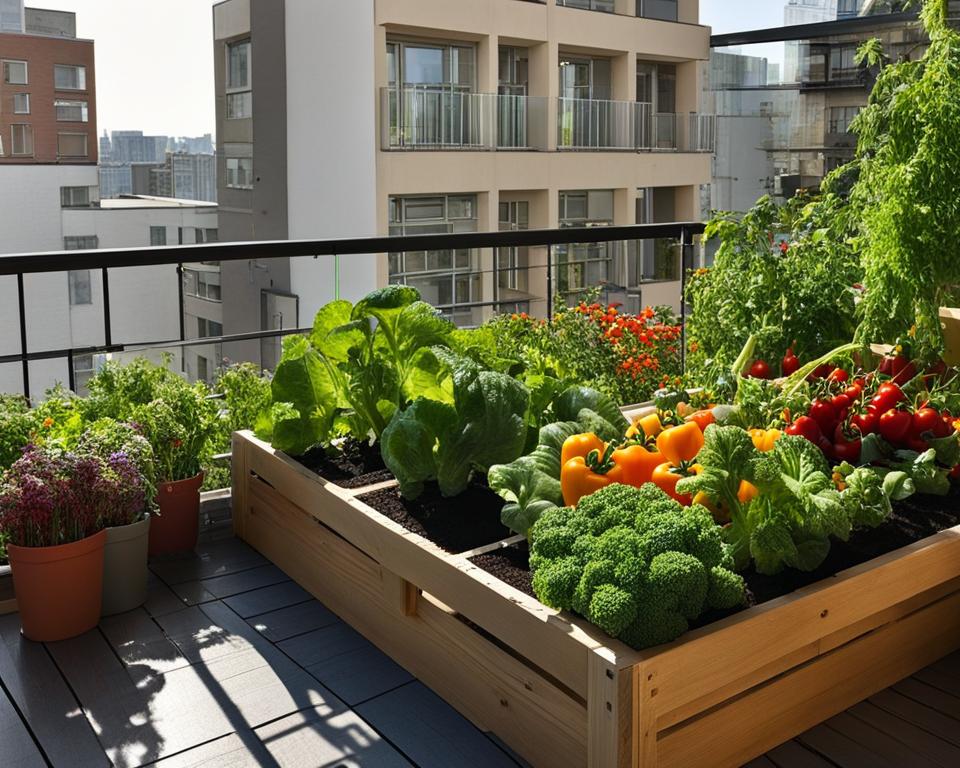
When it comes to growing vegetables in the city, the space you have may be limited, but that doesn’t mean your harvest has to be. Prioritizing quick-growing veggies and high-yield crops will ensure your urban vegetable garden is both productive and enjoyable. Balcony gardening and other forms of small-scale urban agriculture can be surprisingly bountiful with the right approach.
Remember, the key to a successful city garden is to choose plants that will thrive in the unique conditions of urban life.
Consider these vegetables and herbs for your balcony gardening adventure or any small urban vegetable garden setup:
- Lettuce – This leafy green can grow in shallow pots and gives multiple harvests as leaves can be picked and it will keep growing.
- Radishes – Speedy growers, radish seeds can mature in as little as 20 days.
- Beets – These roots are not just edible; their tops can be cooked like spinach, providing a double harvest.
- Zucchini – Although it needs more space, one plant yields plentifully throughout the season.
- Chard – With its continuous harvest, this is a powerhouse for any small garden.
- Herbs (like basil, parsley, and cilantro) – Perfect for tight spaces and they offer fresh flavors just an arm’s reach away.
For those with a bit more space or who want variety, try more permanent plantings:
- Compact strawberries – Their trailing habit makes them ideal for hanging baskets or balcony rail planters.
- Trained fruit trees – Dwarf varieties can be espaliered against a wall to maximize vertical space.
High-yield crops are especially rewarding as they produce more food per square foot. Here’s a snapshot of what you can achieve:
| Crop | Time to Harvest | Yield Potential |
|---|---|---|
| Lettuce | 30-45 days | Continual harvest |
| Radishes | 20-30 days | Multiple bunches per pot |
| Chard | 50-60 days | Cut-and-come-again leaves |
| Zucchini | 70 days | Multiple fruits per plant |
| Herbs | Continuous | Regular clippings |
Embrace the challenges and possibilities of growing vegetables in the city by selecting the right plants. With these choices, you’ll be on your way to a lush, bountiful urban oasis that will be the envy of your neighborhood.
Gaining Vertical: Innovative Urban Gardening Techniques
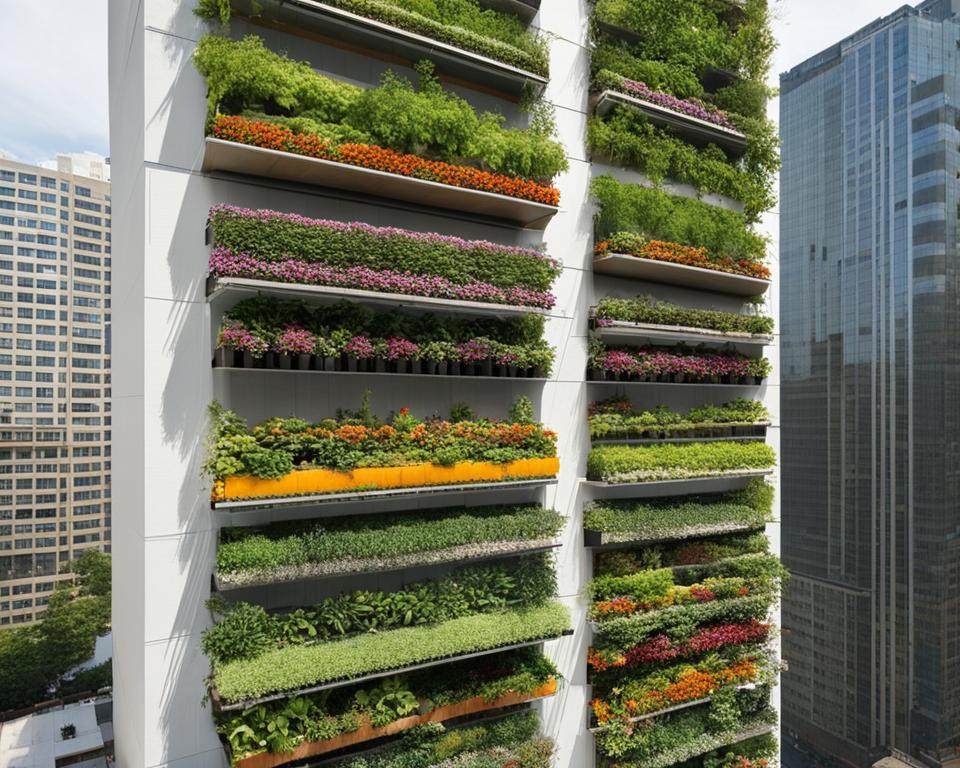
As city dwellers seek to blend nature within their concrete confines, vertical gardening emerges as a smart and stylish solution. This inventive approach allows you to bring the richness of a full garden to even the most limited urban spaces. Imagine cultivating an array of vibrant vegetables that not only provide fresh produce but also transform your living environment into a lush oasis.
What is Vertical Gardening?
Vertical gardening is like scaling the heights of innovation in urban agriculture. It’s a technique that uses vertical space to grow plants, utilizing everything from wall-mounted planters to tall garden structures. Whether you’re working with a small balcony or a plain wall, going vertical can turn these spaces into bountiful green expanses.
Constructing a Living Wall of Greens
Creating a living wall is at the heart of vertical gardening, bringing together aesthetics and efficiency. By employing shelves, trellises, and hanging baskets, you can grow an assortment of plants in a visually stunning formation that’s not only a garden but a piece of living art. This not only saves precious floor space but also makes gardening accessible and enjoyable in any urban setting.
For your city vegetable garden aspirations, vertical gardening offers vast possibilities. From herbs that spice up your kitchen’s flavors to tomatoes that add freshness to your meals, the options are endless. Moreover, a living wall acts as natural insulation, improving the microclimate of your urban abode. Embrace these innovative urban gardening techniques and watch your green space grow up!
Structuring a Rooftop Oasis: Planting Above the City
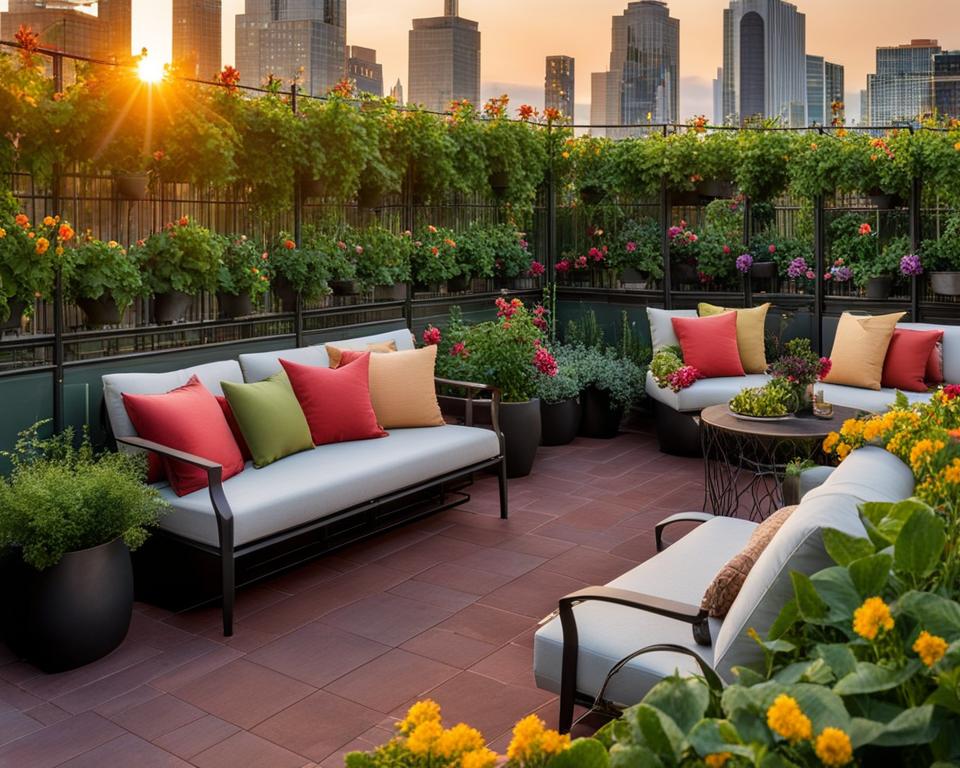
Imagine turning a stark rooftop into a vibrant rooftop oasis teeming with life. Rooftop gardening is more than a trend; it’s a lifestyle movement that empowers you to reclaim and beautify urban spaces. These elevated city gardens not only provide a sanctuary in the sky but also contribute to a sustainable urban ecosystem.
Urban dwellers like yourself can harness innovative urban gardening ideas to cultivate container-grown gardens seamlessly integrated into the concrete canvas of the city. With a pinch of creativity and a dash of dedication, your rooftop refuge can thrive, offering a serene retreat from the bustling streets below.
Engaging in rooftop gardening doesn’t require a green thumb—just the will to transform underutilized areas into blossoming bedrocks. Whether your space is modest or expansive, lightweight containers present a practical solution to weight restrictions on rooftops and balconies. Plus, they afford you the freedom to rearrange your greenery as seasons shift, ensuring your plants receive optimal care year-round.
- Ease of access – No need to crouch or bend excessively, making it ideal for a diversity of gardeners
- Controlled soil conditions – Tailor your soil mix to the specific needs of your plants
- Pest reduction – Elevated plants are less prone to some common ground pests
- Stylistic versatility – Match containers to your architectural style, creating a cohesive and personalized rooftop look
Spearheading a rooftop garden paves the way for a unique, intimate connection with nature. Your very own rooftop oasis doesn’t just whisper solitude; it resonates a symphony of sustainability and serenity. So go ahead, plant your dreams in the sky—where they can grow untethered, lofty above the urban sprawl.
Advantages of Raised Bed Gardening in Urban Spaces
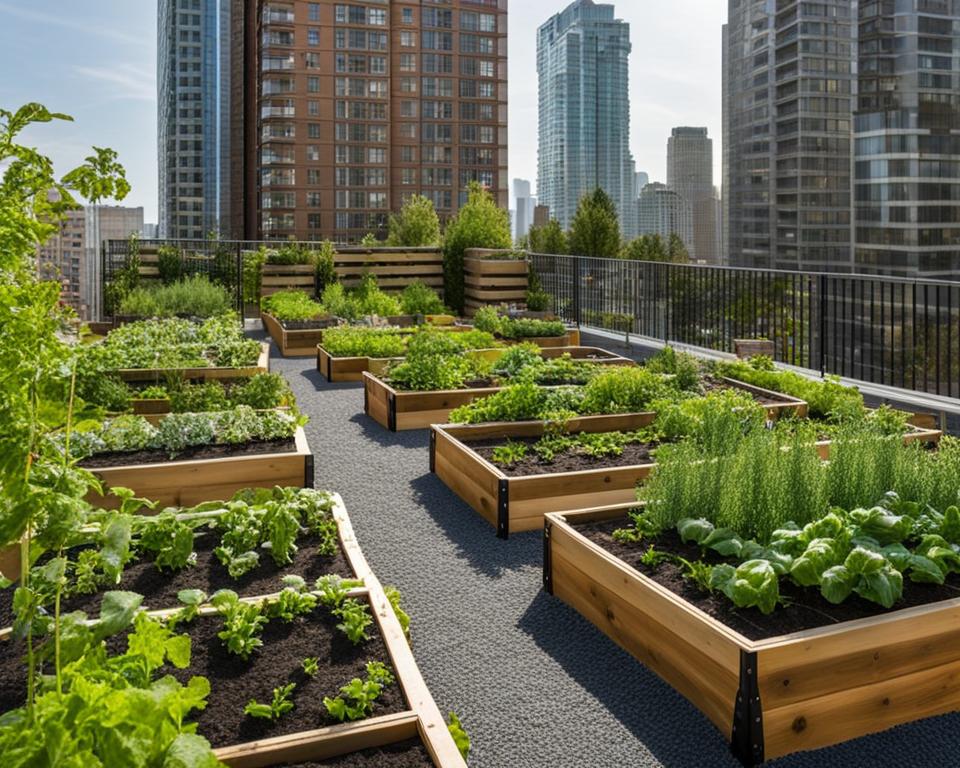
With the burgeoning interest in urban garden designs, raised bed gardening emerges as a prime choice for city dwellers looking to maximize their harvest within limited outdoor spaces. Not only does this method allow for greater efficiency in small gardens, but it also gives you an opportunity to precisely control your soil management and irrigation methods for optimum plant growth.
Designing Raised Beds for Efficiency
The key to successful raised bed gardening lies in its design. Height, width, and length should be carefully calculated, providing enough room for plant roots while still allowing easy reach from all sides. A common guideline is to keep beds no wider than 4 feet, and pathways between beds at least 2 feet wide. By doing so, you contribute to optimizing your yield without sacrificing comfort and accessibility during maintenance.
Soil and Irrigation Tips for Raised Beds
A strategic approach to both soil management and watering tactics can vastly improve your gardening results. An advantage of raised beds is the ability to fill them with a tailor-made soil mix, enhancing drainage and nutrient content ideal for your chosen crops. Moreover, employing efficient irrigation methods, from drip lines to soaker hoses, ensures that water is delivered directly to the root zone, reducing waste and avoiding common diseases associated with overhead watering.
| Feature | Benefits | Considerations |
|---|---|---|
| Elevated Soil Level | Improved drainage and aeration | Ensure stable construction to support soil weight |
| Custom Soil Mix | Optimized nutrient balance for specific crops | May require replenishment or amendment over time |
| Defined Growth Area | Easier pest control and focused resource application | Plan for crop rotation to prevent soil depletion |
| Targeted Irrigation | Water efficiency and reduced disease risk | Regular monitoring to adjust for weather and soil moisture |
Embrace the art of raised bed gardening in your urban space, and you’ll not only cultivate a verdant oasis amidst the concrete landscape but also enjoy the satisfaction that comes from a bountiful harvest right outside your doorstep.
Mastering Balcony Gardening: Your Personal Edible Landscape
Imagine stepping out onto your balcony and being greeted by lush, vibrant greenery—green beans climbing upward, tomatoes ripening in the sun, and a flourish of herbs releasing their inviting scents. In compact urban spaces, balcony gardening is your ticket to cultivating a diverse personal garden. With the right strategies, you can transform your open-air nook into an edible landscape that’s not only a feast for the eyes but a source of fresh vegetables.
It doesn’t require acres of land to be a successful gardener; even the smallest balconies can be converted into a profusion of edible plants. Here’s how to get started:
- Select the right containers: Choose containers that fit your balcony space and accommodate the root size of your chosen plants.
- Utilize vertical space: Think trellises and hanging planters for vine plants and vertical growth.
- Plant strategically: Combine plants that thrive together; for example, tomatoes with basil, which may help repel pests naturally.
Additionally, remember to use quality soil and provide adequate water and nutrients to ensure the health and vigor of your crops. With these practices, you can enjoy the fulfillment of hand-picking fresh produce from your own personal garden, no matter the scale of your living quarters.
| Plant Type | Container Size | Sunlight Needs | Watering Frequency |
|---|---|---|---|
| Herbs (Basil, Cilantro, Parsley) | Small to medium pots | Full to partial sun | Regularly, when soil feels dry |
| Tomatoes | Large pots or buckets | Full sun | Deep watering once a week |
| Leafy Greens (Lettuce, Spinach) | Medium containers | Partial shade to full sun | Consistent to keep soil moist |
| Strawberries | Hanging baskets or troughs | Full sun | Every 1-2 days |
Remember that every plant in your edible landscape is an opportunity to experience the joy of gardening and the taste of homegrown food. Whether you’re looking to enhance your cooking with fresh herbs, munch on crisp greens, or savor the sweetness of sun-ripened strawberries, balcony gardening is a fulfilling venture that highlights what can be done in compact urban spaces.
Container Gardening: A Versatile Approach to Growing Vegetables in the City
In the heart of urban settings, container gardening emerges as a brilliant solution, allowing you to indulge in the delights of urban vegetable gardening regardless of space constraints. This versatile gardening approach can be a game-changer for those seeking to harvest homegrown produce from their concrete abodes.
Selecting Containers for Different Vegetables
Selecting the right container is pivotal in accommodating the specific needs of each vegetable you wish to grow. Understand that a tomato plant may require deeper pots for its roots, while herbs thrive in more compact spaces. Your container gardening accessories should reflect both the needs of your plants and the unique character of your living space.
Maintaining Moisture and Nutrients in Container Plants
A mainstay of container gardening success is maintaining moisture and ensuring your plants have nutrient-rich soil. Unlike traditional gardening, containers can dry out quickly; checking soil moisture should become part of your daily routine. Consider integrating self-watering containers or a drip irrigation system to keep your urban garden flourishing.
| Vegetable Type | Recommended Container Size | Moisture Needs | Nutrient Requirements |
|---|---|---|---|
| Tomatoes | 5-gallon bucket or larger | Consistent watering to avoid blossom end rot | High phosphate and potassium |
| Leafy Greens | Shallow 2-gallon container | Even moisture to prevent wilting | Nitrogen for leaf production |
| Herbs | 6 to 12 inches deep pots | Allow soil to dry between watering | General-purpose fertilizer |
| Root Vegetables | At least 12 inches deep containers | Consistent moisture, avoid waterlogging | Balanced fertilizer |
| Peppers | 2-gallon container or larger | Keep soil slightly moist | Calcium to prevent blossom end rot |
Remember, the key to container gardening is observation and adaptation. Be prepared to adjust your watering frequency and fertilization based on the unique demands of your urban garden and the changing seasons. With attentiveness and adaptability, you’ll enjoy the bounty of a vibrant vegetable garden right in your city dwelling.
Thriving Edible Gardens in the Concrete Jungle
Imagine your urban environment transformed into a vibrant canvas of green. With urban vegetable gardening, this is not only possible but is becoming an essential part of life for city dwellers seeking sustainability and a touch of nature. Edible gardens flourish in the midst of the concrete jungle, turning balconies, rooftops, and even the smallest of spaces into fertile grounds for fresh produce cultivation. This is not just about beautification—it’s about reclaiming and revitalizing our urban landscapes.
In your quest for a greener cityscape, consider every inch of space as potential ground for an edible oasis. Cityscape greenery defies traditional ideas of farming, introducing innovative ways to grow food where you’d least expect it. Vertical gardens, window boxes filled with herbs, and trellised vines crisscrossing balcony railings—all contribute to a thriving green space that breathes life into the urban expanse.
There’s a profound beauty in the juxtaposition of nature and the built environment. Your initiative in urban vegetable gardening not only provides you with organic, homegrown vegetables but also sets forth a ripple effect—the creation of micro-environments that support local ecosystems, promote biodiversity, and offer a haven for pollinators. Each edible garden becomes a tile in the larger mosaic of cityscape greenery, contributing to a collective effort that makes our cities not only greener but also more resilient.
So, roll up your sleeves and let’s get to work. Start simple: grow a tomato plant, nurture a berry bush, or tend to a tray of microgreens. Soon you’ll become part of a larger movement, finding camaraderie among fellow urban gardeners, as you enjoy the literal fruits of your labor. Embrace the journey of turning the concrete jungle into a patchwork of plentiful, life-sustaining edible gardens.
Urban Vegetable Gardening: Cultivating Fresh Produce in the Heart of the City
As an urban dweller, you have the unique advantage of experiencing firsthand how the city’s heartbeat influences the growth of your garden. Where towering structures shade and concrete retains warmth, urban microclimates emerge, creating pockets of potential for cultivating fresh produce amidst the metropolitan buzz.
Understanding Urban Microclimates for Better Harvests
Intricacies of urban agriculture entail navigating these microclimates to your advantage. Recognizing areas that receive more sunlight, understanding patterns of wind, or identifying where heat accumulates can turn your gardening from a hobby into a bountiful endeavor. The secret lies in strategically placing your planters or adjusting watering schedules to mirror the urban landscape’s unique conditions.
Engaging Your Community in Urban Agriculture
But why garden in isolation when community engagement can enrich the experience? Initiating a gardening project within your neighborhood not only fosters connections but also instills a shared sense of responsibility and pride. Whether it’s a communal herb garden on a shared rooftop or a cooperative effort to manage a green space, community gardens become not just sources of sustenance but also blossoming centers of collaboration.
Imagine stepping out into the heart of the city, where each balcony and rooftop brims with greenery, where every community embraces the transformational power of the soil. This green tapestry doesn’t just symbolize growth — it’s a testament to a city’s resilience and the collective spirit of its inhabitants. So plant, nurture, and harvest, knowing that you’re part of an urban evolution, one seed at a time.
Organic Practices for Urban Gardeners: Boosting Plant Health Naturally
As an urban gardener, you are the steward of your city space, cultivating life amidst concrete and steel. Embracing organic gardening principles not only bolsters plant health but also preserves the integrity of our environment. Utilizing natural fertilization techniques, you can enrich your urban vegetable garden in a way that’s harmonious with nature. This sustainable approach to gardening ensures that the fresh produce on your plate is free of chemical residues and full of flavor and nutrients.
Feeding your plants shouldn’t come at the cost of the world around you. With natural fertilization strategies, such as applying organically sourced chicken manure pellets, you’re providing a wholesome, slow-release form of nutrients directly to the roots of your plants. By nurturing your garden with these organic materials, you’re not only enhancing growth but also contributing to building a resilient soil ecosystem. Meanwhile, methods like worm composting transform your kitchen scraps into a rich, living amendment, teeming with beneficial microbes that promote productivity and vitality in your garden beds.
Integrating these sustainable practices into your urban oasis ensures that you’re not just growing plants—you’re cultivating an eco-centric philosophy. This approach extends beyond your balcony or rooftop; it’s a pledge to the larger environmental movement, one potted tomato or window box of herbs at a time. By gardening organically, you’re not just a part of your community; you’re also an agent of change, demonstrating that even in the densest urban spaces, we can foster greenery and health that’s in tune with the planet’s wellbeing.
FAQ
How do I start urban vegetable gardening in limited city spaces?
You can start urban vegetable gardening even in limited city spaces by making use of small areas like windowsills, balconies, patios, decks, or rooftops. Begin with container gardening, which allows you to grow a variety of vegetables in pots that have good drainage and can be placed in spots that receive adequate sunlight.
What are some effective small-space gardening techniques for urban settings?
Two effective techniques for small-space gardening in urban settings are vertical gardening and container gardening. Vertical gardening involves growing plants upward on structures such as shelves or trellises to maximize available space, while container gardening uses pots and planters that can be arranged on any flat surface, such as a balcony or rooftop.
What types of vegetables are best suited for an urban vegetable garden?
Fast-growing and high-yield vegetables are ideal for urban vegetable gardens. Some of the best options include lettuce, radishes, beets, zucchini, chard, and compact varieties of strawberries or fruit trees. Herbs also thrive well in small spaces and add flavor to your garden.
Can I do rooftop gardening if I am concerned about weight limitations?
Yes, you can engage in rooftop gardening while addressing weight limitations by using lightweight containers and soil mixes. It’s important to assess the structural capacity of your rooftop before setting up the garden and to consider using materials that offer both portability and durability.
What are the benefits of raised bed gardening in urban areas?
Raised bed gardening offers several benefits in urban areas, including improved soil drainage and aeration, higher yields due to concentrated resources, reduced soil compaction, and ease of access for garden maintenance. Raised beds can be filled with the optimal soil mixture and include efficient irrigation systems tailored to your plants’ needs.
How do I select the right containers for different vegetables in an urban garden?
Selecting the right containers for different vegetables involves considering the size and depth requirements of each plant’s root system. Shallow-rooted vegetables can be grown in smaller containers, while larger, deep-rooted plants like tomatoes and beans need bigger pots to accommodate their growth.
How can I maintain adequate moisture and nutrients in my container garden?
To maintain adequate moisture, water container plants more frequently, as they can dry out faster than plants in the ground. For nutrients, use organic fertilizers and consider practices like worm composting to enrich the soil. Always ensure containers have proper drainage to avoid waterlogging.
What are organic practices that urban gardeners can adopt to promote plant health?
Urban gardeners can adopt organic practices such as using natural compost, avoiding synthetic pesticides and fertilizers, and employing crop rotation and companion planting to promote plant health and sustainability. These methods not only benefit the plants but also help maintain a healthy urban ecosystem.
How can I understand and adapt to urban microclimates when gardening in the city?
Understanding urban microclimates involves observing the specific conditions in your gardening space, such as sun exposure, wind patterns, and heat absorption by surrounding structures. Adapt your gardening practices according to these conditions by selecting suitable plants and providing protection or shade where needed.
How can I engage my community in urban agriculture?
Engage your community in urban agriculture by starting or participating in community gardens, organizing workshops or seed swaps, and sharing produce. Collaboration can lead to shared knowledge, resources, and a broader impact on local food sustainability and gardening success.

